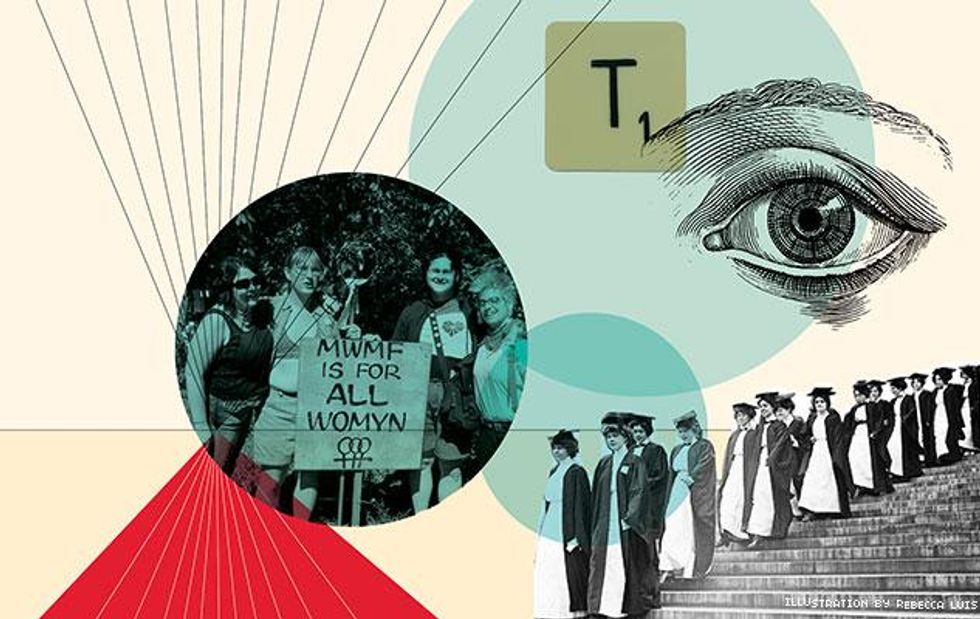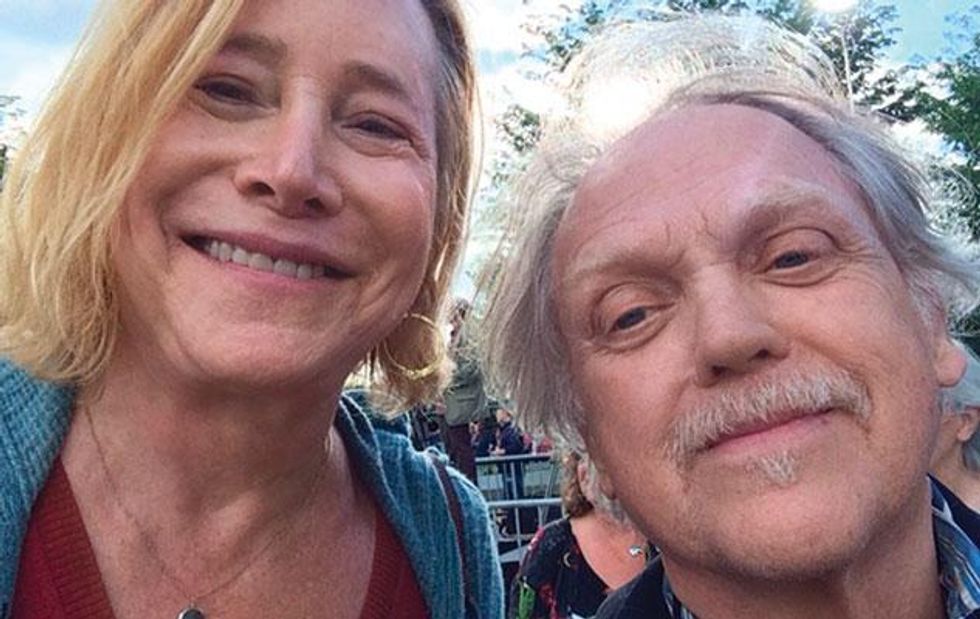
While there has been much ferment in the political arena recently, with marriage equality oral arguments at the Supreme Court and Caitlyn Jenner's public coming out to 17 million viewers as a trans woman, there has been significant change going on beneath the surface in the evolution of the cultural landscape. This has occurred in the context of the changing perception of trans women from both the lesbian and gay male perspectives. I'll begin with the lesbian side.
Recently Smith College -- the grande dame of women's colleges, the first female college founded by a woman, and the leader among the Seven Sisters -- voted to admit trans women. The board of trustees stated:
"The board's decision affirms Smith's unwavering mission and identity as a women's college, our commitment to representing the diversity of women's lived experiences, and the college's exceptional role in the advancement of women worldwide."
Smith had ceded the lead to Mills College, then Mount Holyoke and a string of others, and dithered in terms of welcoming trans women as applicants, even while students who came out as trans men after admissions were allowed to stay. Such a differential within Smith's policy had made it seem to trans activists that Smith was mired in a trans-exclusionary radical lesbian separatist philosophy, which views trans men as deluded cisgender lesbians and refuses to see trans women as real women. This very welcome action doesn't simply add Smith to the list of the other women's colleges; it kills that separatist argument in administrative academia once and for all.
Smith's decision followed very closely on the decision to end the Michigan Womyn's Music Festival, a venerable lesbian institution for the past four decades, held annually on "The Land" in upper Michigan. MichFest has been mired in conflict regarding trans women since 1991, when a trans woman was escorted off the land for the first time.
The festival, like Smith, often hosted trans men who had once been lesbian women, but officially asked out trans women to stay home. While many women, including trans women living under the festival's "don't ask, don't tell" policy, experienced life-changing and life-affirming weeks during 40 Augusts past, the larger LGBT community last year had finally spoken out against the discriminatory admissions policy with a petition, created by Emily Dievendorf (then executive director of Equality Michigan), calling for a boycott of MichFest until its exclusionary policies were changed.
Maybe as a result of fatigue and the simple passage of time, or the behind-the-scenes efforts of Dievendorf, Kate Kendell of the National Center for Lesbian Rights, and Rea Carey of the National LGBTQ Task Force, as well as from trans advocates nationwide -- or most probably a combination of all of the above -- Lisa Vogel, the co-founder and lifetime executive director of the MWMF, chose to signal this summer's festivities as the last. Unfortunately, rather than going out on the right side of history, Vogel has remained defiant until the end. Surviving intact as a separatist movement will be a Pyrrhic victory, and the demise of the festival, along with the increasingly public recognition by prominent national cisgender lesbians that trans women are women, is another signal that lesbian society is growing in its understanding of the meaning of gender identity and the lives of trans persons.
 Dana Beyer with Jim Fouratt
Dana Beyer with Jim FourattFrom the other end of the gay divide, the male side, I have reported on the long-held philosophical beliefs of some gay men, rooted in the '70s, that trans women were really just extremely gay men who were so ashamed of their homosexuality that they were willing to undergo surgical and social transition to have sex with men. The man most closely associated with this philosophy is Jim Fouratt, a founder of the Gay Liberation Front in New York following the Stonewall Uprising.
Over May Day weekend in Washington, D.C., I had the honor of attending a reunion of people involved with the Vietnam War peace movement on the 50th anniversary of the escalation of the war with ground troops. Titled "Vietnam: The Power of Protest," the event brought together for the first time anti-war luminaries such as Marcus Raskin, Arthur Waskow, Tom Hayden, Cora Weiss, Dave McReynolds, Richard Fernandez, Staughton Lynd, Judith Lerner, George Regas, Peter Yarrow, Todd Gitlin, Mark Rudd, Frances FitzGerald, Julian Bond, Heather Booth, Ron Dellums, and Daniel Ellsberg.
Many of the attendees not only had been active in the anti-war movement but had been Freedom Riders as well. One of the purposes of the conference was to highlight the absence of any official markers of the movement that helped end the Vietnam War, an absence that is starkly contrasted by the growing industry of civil rights movement recognition and its resultant tourism.
One highlight of the conference was a walk to the Martin Luther King, Jr. Memorial a mile and a half away from the conference center, during which time I met, for the first time, Jim Fouratt. As is often the case, my in-person experience of the man was nothing like the caricature that had been built up in my mind over the years by rumor and innuendo. I wasn't interested in refighting old battles or determining the truth of what was said or wasn't said back in the '70s; I was concerned with the here and now and what I believed was the persistence of those old transphobic theories that had been attributed to Jim.
We listened to each other and I came away with an understanding of his concerns, as a feminine gay man who had often been thrown under the gay bus by a community that feared its own feminine side, and who was determined to maintain the image that every gay man is a masculine top. I explained that while there are straight men who cross-dress for erotic or sensual pleasure, the trans women who are fighting for recognition as women, both legal and social, are truly women, and we have always been women. That we all have a gender identity, including gay men such as him, and that his gender identity is male, while mine is female. Where we differ is on the spectrum of gender expression. We agreed on the need for mutual respect from both sides, and the need for gay men to overcome the inherent misogyny that denigrates and marginalizes feminine gay men as well as trans women.
We are all fighting for recognition, understanding, and acceptance, and we have a tendency to disparage one another, particularly when we are fighting for media exposure. I sense that slowly, with the promotion of different aspects of the gender expression rainbow as manifested in Laverne Cox, RuPaul, and Caitlyn Jenner, that mainstream America, as well as LGBT America, is beginning to understand our differences as well as our similarities. I am encouraged when I see Bill Maher admit his confusion as to why the T organizes along with the LGB, and former congresswoman Jane Harman calmly explains to him that all sexual minorities have the need to stick together to increase our numbers and influence. The process feels glacial at times, but it is actually proceeding at an accelerating pace.
Jon Stewart, in speaking with George Stephanopoulos about Caitlyn Jenner's coming out, asked, "For the people who are upset about that, it's got nothing to do with you. Why do you care?" George responded, "Let him be." And Stewart answered, "Thank you. Yes. That's right." Let us all be.


 While there has been much ferment in the political arena recently, with marriage equality oral arguments at the Supreme Court and Caitlyn Jenner's public coming out to 17 million viewers as a trans woman, there has been significant change going on beneath the surface in the evolution of the cultural landscape. This has occurred in the context of the changing perception of trans women from both the lesbian and gay male perspectives. I'll begin with the lesbian side.
While there has been much ferment in the political arena recently, with marriage equality oral arguments at the Supreme Court and Caitlyn Jenner's public coming out to 17 million viewers as a trans woman, there has been significant change going on beneath the surface in the evolution of the cultural landscape. This has occurred in the context of the changing perception of trans women from both the lesbian and gay male perspectives. I'll begin with the lesbian side. Dana Beyer with Jim Fouratt
Dana Beyer with Jim Fouratt
Charlie Kirk DID say stoning gay people was the 'perfect law' — and these other heinous quotes